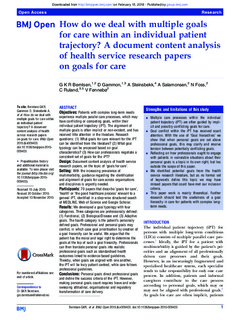| dc.contributor.author | Berntsen, G.K. | |
| dc.contributor.author | Gammon, B.D. | |
| dc.contributor.author | Steinsbekk, A. | |
| dc.contributor.author | Salamonsen, A. | |
| dc.contributor.author | Foss, N. | |
| dc.contributor.author | Ruland, C. | |
| dc.contributor.author | Fønnebø, V. | |
| dc.date.accessioned | 2018-02-16T13:07:44Z | |
| dc.date.available | 2018-02-16T13:07:44Z | |
| dc.date.issued | 2015 | |
| dc.identifier.citation | Berntsen, G. K., Gammon, B. D., Steinsbekk, A., Salamonsen, A., Foss, N., Ruland, C. & Fønnebø, V. (2015). How do we deal with multiple goals for care within an individual patient trajectory?: A document content analysis of health service research papers on goals for care. BMJ Open, 5(12). | nb_NO |
| dc.identifier.uri | http://hdl.handle.net/11250/2485414 | |
| dc.description.abstract | Objectives: Patients with complex long-term needs experience multiple parallel care processes, which may have conflicting or competing goals, within their individual patient trajectory (iPT). The alignment of multiple goals is often implicit or non-existent, and has received little attention in the literature. Research questions: (1) What goals for care relevant for the iPT can be identified from the literature? (2) What goal typology can be proposed based on goal characteristics? (3) How can professionals negotiate a consistent set of goals for the iPT?
Design: Document content analysis of health service research papers, on the topic of ‘goals for care’. Setting: With the increasing prevalence of multimorbidity, guidance regarding the identification and alignment of goals for care across organisations and disciplines is urgently needed.
Participants: 70 papers that describe ‘goals for care’, ‘health’ or ‘the good healthcare process’ relevant to a general iPT, identified in a step-wise structured search of MEDLINE, Web of Science and Google Scholar.
Results: We developed a goal typology with four categories. Three categories are professionally defined: (1) Functional,
(2) Biological/Disease and (3) Adaptive goals. The fourth category is the patient’s personally defined goals. Professional and personal goals may conflict, in which case goal prioritisation by creation of a goal hierarchy can be useful. We argue that the patient has the moral and legal right to determine the goals at the top of such a goal hierarchy. Professionals can then translate personal goals into realistic professional goals such as standardised health outcomes linked to evidence-based guidelines. Thereby, when goals are aligned with one another, the iPT will be truly patient centred, while care follows professional guidelines.
Conclusions: Personal goals direct professional goals and define the success criteria of the iPT. However, making personal goals count requires brave and widesweeping attitudinal, organisational and regulatory transformation of care delivery. | nb_NO |
| dc.publisher | BMJ Open | nb_NO |
| dc.rights | Navngivelse-Ikkekommersiell 4.0 Internasjonal | * |
| dc.rights.uri | http://creativecommons.org/licenses/by-nc/4.0/deed.no | * |
| dc.subject | goals for care | nb_NO |
| dc.subject | iPT | nb_NO |
| dc.subject | individual patient trajectory | nb_NO |
| dc.subject | personal goals | nb_NO |
| dc.subject | professional goals | nb_NO |
| dc.title | How do we deal with multiple goals for care within an individual patient trajectory?: A document content analysis of health service research papers on goals for care | nb_NO |
| dc.type | Journal article | nb_NO |
| dc.source.volume | 5 | nb_NO |
| dc.source.journal | BMJ Open | nb_NO |
| dc.source.issue | 12 | nb_NO |

